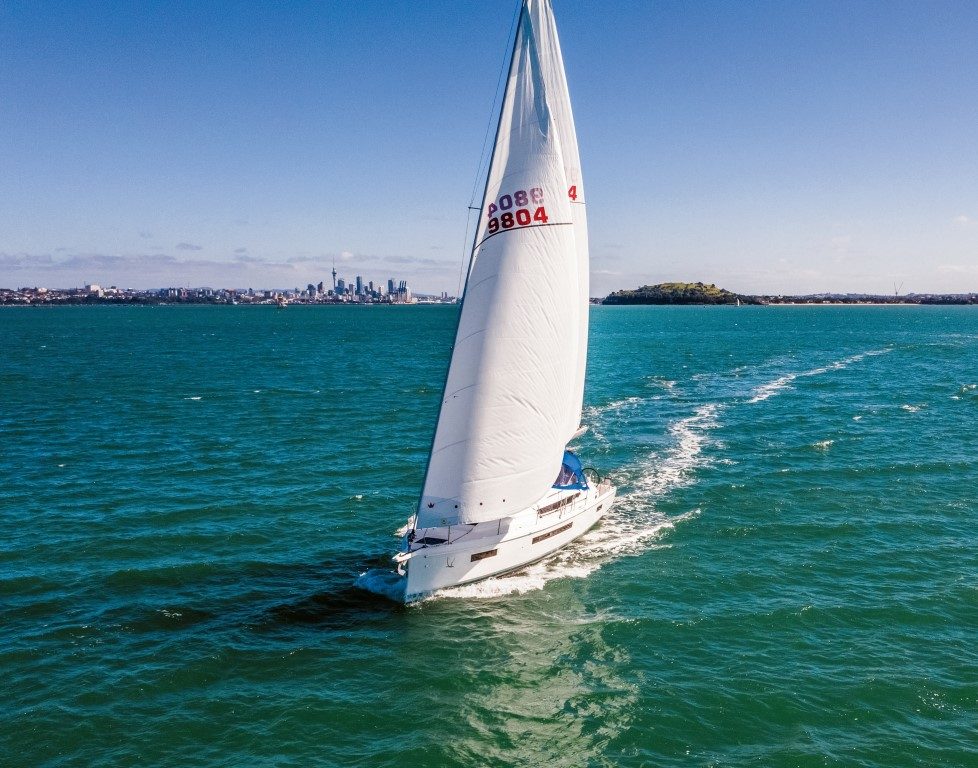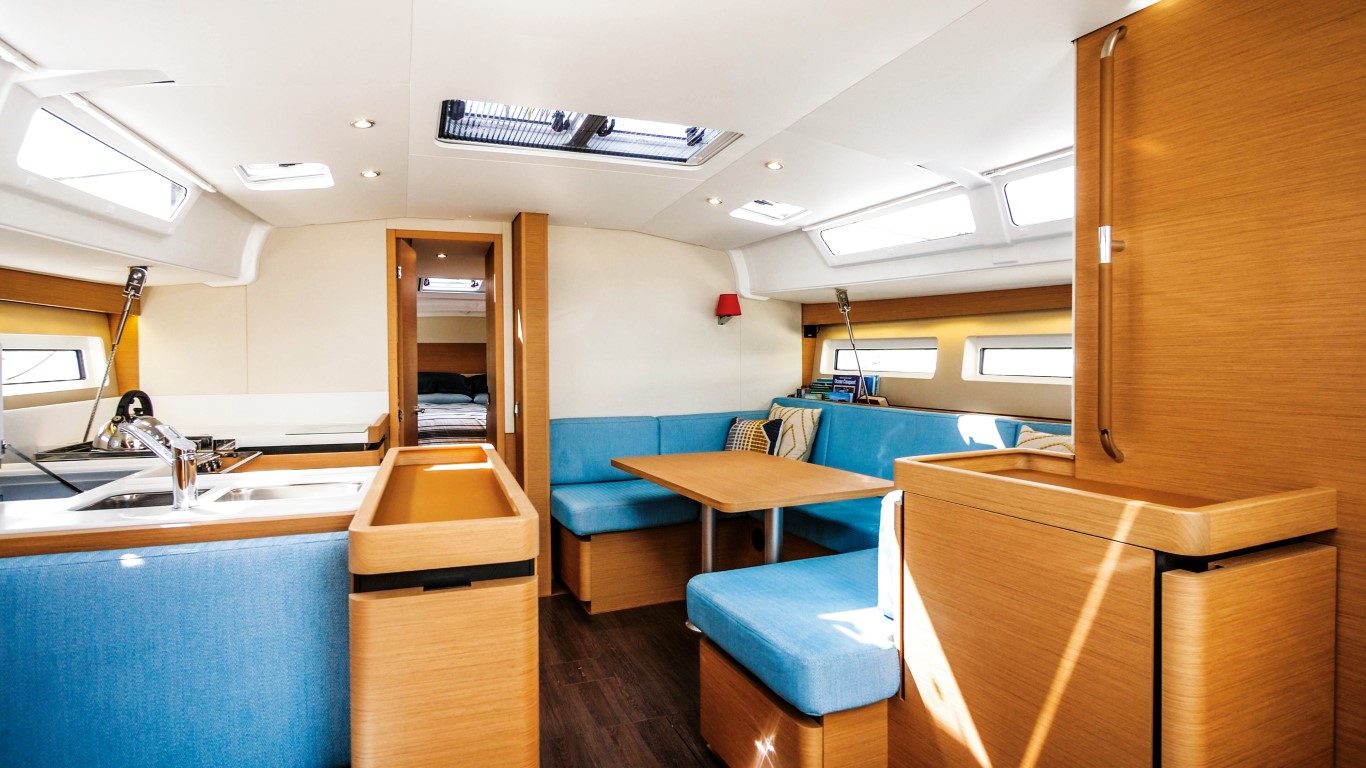‘Behemoth’ is a word which springs to mind or, perhaps more nautically, ‘leviathan’.
- Tonnes of space
- Sail controls well thought out for short-handed cruising
- Very stable. Hard chines limit heel
- Relatively modest rig as reviewed
One of the advantages of reaching a certain age is that you know what you want and aren’t afraid to ask for it. The owner of this Jeanneau Sun Odyssey 490, having owned a slightly smaller Jeanneau for more than 20 years, knew he’d come back for more when it came time to upgrade.
Papillon (French for butterfly) is the first Sun Odyssey of its size to reach New Zealand. She arrived over the winter and was commissioned in Auckland before being sailed down to her new home in Wellington.
Owner Phillip Beavon and his partner Suzanne Wood plan to spend their summers on extended cruises around the top of the South Island – the Marlborough Sounds, Tasman Bay – so they were looking for a boat with plenty of space and creature comforts.

Perhaps surprisingly for a boat which is nigh-on 50-feet long, Papillon has only two cabins. While the 490 can be specified to have three, four or even five separate cabins and up to four heads, Beavon went for the ‘technical room’ option.
This sees the port aft cabin fitted out as a multi-purpose storage space, for keeping all the ‘boatie’ stuff in one place, out of sight, ship-shape and Bristol fashion. There is also access to the inverter, shore-power converter and switch panel in this room, while the 80hp Yanmar 45H diesel (up-specced from the standard 57hp to deal with Wellington conditions) is accessed by lifting the companionway steps.

To generate a very large interior volume, the 490 is very beamy – a maximum of 4.49m, carried right aft – and she has a full-length hard chine running just above the waterline. Together, these things mean a lot can be packed into the boat, which was designed by America’s Cup and luxury yacht designer Philippe Briand, with interiors by Jean-Marc Piaton.

Getting aboard from the marina finger is easy, thanks to a ladder which clips into the toerail mid-sidedeck. These sidedecks then slope down to the cockpit, the thick toerail remaining at the same height to maintain the line of the deck while creating a kind of ramp. This means you don’t have to clamber over the cockpit coamings to get yourself or gear onboard.
For entry from the water, and launching and retrieval of a tender, a large boarding platform folds down to create an open transom. On this boat it’s operated with a rope purchase; it can also be automated.
Thanks to the boat’s beam the cockpit is very large and seating is generous. The table has a leaf either side which folds up from a central console; one leaf can be folded out for table space while the other side is left clear for easy access through the cockpit and down the companionway.

The clean and uncluttered nature of the cockpit is enhanced by the fact there are no sailing-related bits of string lying around; the jib sheets and German mainsheet system run under the cockpit coamings to emerge right at the pair of large H50 Harken winches just forward of the helmstations. Control lines for halyards are kept out of the way on the cabintop, leading to another pair of Harken winches, H45s this time. None of the winches on this boat are electric, but that is an option.
The wheels are spaced far apart in this beamy part of the boat, for good visibility down the side decks, and the boat has twin rudders for grip and control.

Heading down below, we can see why Beavon thinks of this boat as an apartment on the water. In contrast to his previous boat’s 1990s-style dark timber interior, Papillon is all about light and bright. Cabinetry is light teak and the flooring pale oak, with cheerful aqua-coloured upholstery. Little touches like crimson lampshades and the smooth, stylish curves of the cabinetry add to the European look.
There are some clever storage solutions, too, including a lift-out cutlery drawer and a wine-storage locker under the floor, and large solid fiddles around the edges of cabinets which double as grabrails.

At the bottom of the companionway stairs is a large nav station, which doubles as a second seating area, as it has squabs on both sides. Jeanneau’s aim with the Sun Odyssey range is to combine modern design with traditional touches, and this lift-top table and its adjacent analogue clock and barometer reminds you that you are, in fact, on a yacht. Beavon’s opted not to go for extensive electronics here; there is a single Raymarine screen up at the port helm and other nav will be done by tablet or traditional chart.
Forward of this nav station is the U-shaped galley, with twin sinks facing aft, a three-burner gas hob and oven, and a microwave which pops up out of the bench when required. There is a large top-loading fridge in the bench, also accessible through a door in the cabinetry, and a second underbench fridge unit mounted further forward.

Opposite the galley is the saloon area, with U-shaped seating around a large table. Throughout this space there is masses of headroom; our photographer is 1.95m tall and his head didn’t even graze the ceiling. There is also plenty of light coming in through the through-hull windows and overhead hatches.
Aft to starboard is the guest cabin, a decent-sized double running back under the cockpit. It has a semi-en suite head and shower, which doubles as the day head.
The owner’s cabin in the bow is one of the more spacious and luxurious we’ve seen on a boat this size, with a ‘spiral’ design leading you into the space and around to the shower compartment and vanity on the starboard side. The head is in a separate compartment on port side, and there is more than enough room for two people to dress and use the bathroom without getting in each other’s way. Another bonus: the bed is both queen size and rectangular, so you can use regular, off-the-shelf bedding.

On the wind
Auckland turned on a fresh spring day for our test sail, but 15 knots is nothing to a Wellingtonian, so we head out of Orakei Marina, using the bow thruster for maximum manoeuvrability. The mainsail is in an in-mast furler and the 120% cent genoa is on a furler too, so getting the sails up and trimmed is no problem; Beavon wanted the boat to be easily handled by just two people.
These standard two sails are the only ones he has ordered so far, and the boat seems quite under-canvassed; this main is only two-thirds the size of the main on the optional ‘performance’ rig on this boat, which is 1.6m taller.

Nonetheless, the Jeanneau feels smooth and confident on a reach, and we manage to break through the 10-knot barrier without too much trouble. As the boat starts to power up and heel, you can feel the chine dig in and boat settles into a steady groove at a comfortable angle. The twin rudders stay in touch and provide good control and responsiveness as the puffs come and go.
Papillon is immaculate now, and, judging by the condition of Beavon’s previous boat, it’s easy to imagine her staying that way for many years. Thanks to French design ingenuity, there’s a place for everything, and everything is in its place.
Perfect for a couple flitting between the jewel-like anchorages in the Sounds.
‘Behemoth’ is a word which springs to mind or, perhaps more nautically, ‘leviathan’.
White Pointer has earned the respect of discerning customers in New Zealand and Australia, attracting a loyal and ever growing following for its high-quality, rugged and totally dependable aluminium trailer boats.
The hardtop SP635 shares the same underpinnings as the popular SF 635 which was a completely new model back in 2020.
The pride and joy of a multi-generational family, Bliss resides on a pier that’s home to a couple of other Elite motor launches – Sandspit Marina is a hot-spot for the Bill Upfold-designed vessels, with several calling this small marina home.